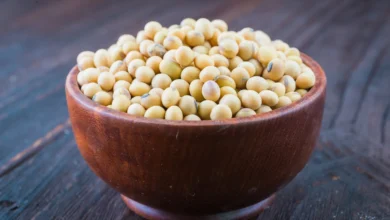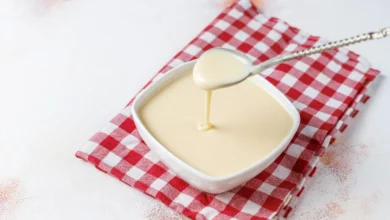Dehydrated Orange Slices: Cocktails and Beyond

Think “dried” means boring? Not when it comes to citrus! Dehydrating fresh orange slices is an easy way to lock in that bright flavor. It’s a time-consuming process, but the oven does most of the work. This hands-off approach leaves you just waiting for deliciousness!
Contents
- Dehydrated Orange Slices
- Dehydrated Orange Slices Recipe
- Ingredients
- Directions
- Notes
- What Can I Do With Dried Citrus?
- How to Store Dried Citrus
- Frequently Asked Questions
- Can you eat dehydrated orange slices?
- How long does it take to dehydrate orange slices?
- What can you do with dried oranges?
- How long will dried oranges last?
- How do you keep dehydrated oranges from molding?
- Can you make dehydrated oranges in the oven?
- How long does it take to dehydrate an orange slice?
- Are dehydrated orange slices good?
- Are dried orange slices edible?
- Can you dry orange slices without a dehydrator?
Dehydrated Orange Slices
Capture the essence of citrus season all year long by making dehydrated orange slices. This simple process locks in that bright flavor, so you can enjoy your favorite drinks, desserts, and decorations any time. Let’s learn how to dehydrate oranges with ease!
What are Dried Orange Slices?
Dried orange slices are exactly what they sound like – slices of fresh oranges that have been dehydrated by either air or heat. This process of drying involves reducing the water content in the fruit, which helps to preserve the orange slices for longer periods. Think of it like fruit jerky, but with a tangy citrus twist!
The Farmer’s Almanac lists drying as one of the four main methods used to preserve fruit, alongside freezing, jam-making, and pickling. It’s a technique that’s been used for centuries to make the most of seasonal harvests.
Health Benefits
Dehydrated orange slices offer a concentrated dose of citrus flavor with several potential health benefits. They’re a good source of vitamin C, a powerful antioxidant that boosts immunity and supports skin health. Dehydrated oranges also contain fiber, promoting digestive health and aiding in healthy weight management. Plus, their naturally sweet flavor can satisfy cravings without the added sugar found in many processed snacks. However, since dehydration concentrates sugars, remember that dehydrated orange slices are best enjoyed in moderation as part of a balanced diet.
Why This Recipe Works
While you could certainly purchase a dehydrator, this recipe requires nothing more than your oven and a bit of patience. Most ovens have low enough temperature settings for dehydrating, and their instructions guide you through the process. Of course, a dehydrator offers better control, but sometimes an uncomplicated approach yields just as tasty results!
The beauty of drying orange slices is their portability. Once dried, they can be tossed in a ziplock bag and taken on outdoor activities like a hike. Having dried citrus on hand makes for a quick boost of energy and flavor with none of that sticky juice residue.
Plus, this easy recipe can be applied to various citrus fruits, including limes, lemons, tangelos, and more! For me, a personal favorite is using blood oranges, but experiment with any type of citrus you grow or love. If your fruit supply can’t keep up with your demand, don’t worry – dehydrated citrus lasts for ages. This means if you dehydrate in bulk, you can enjoy those delicious flavors year-long.
6 Ways to Use Dehydrated Oranges
- Flavor your drinks: Infuse naturally delicious citrus flavor into both hot and iced tea. Dried oranges also elevate plain water. Just try adding a few slices to your next ice water!
- Garnish to perfection: Dehydrated oranges make cocktails and even wine look a touch fancier.
- Flavor boosters: Prepare flavorful syrups by stewing dehydrated oranges, or simmer some in your next elderberry shrub.
- Festive decorations: Dehydrated orange slices, combined with cinnamon sticks, make lovely gift embellishments or can be strung into a garland for the holidays.
- Beyond oranges: Dehydrated lemons or limes offer the same possibilities with unique flavor profiles!
- Summer taste, year-round: Prepare enough dehydrated oranges to enjoy that naturally delicious citrus flavor long after the fresh fruit is gone!
What Citrus Can I Dehydrate?
The great news is that you have options! While any citrus can be dehydrated, here are some popular choices along with their typical drying times:
- Dried Lemons (2-3 hours): Tart and tangy, a classic addition to teas and drinks.
- Dried Limes (2-3 hours): Similar to lemons with a slightly more nuanced flavor.
- Dried Blood Oranges (3-4 hours): Beautiful color and deep, sweet-tart flavor.
- Dried Cara Cara Oranges (3-4 hours): Less acidic than typical oranges, perfect for snacking.
- Dried Navel Oranges (3-4 hours): The classic sweet orange flavor intensified.
- Dried Grapefruit (5+ hours): Takes the longest, but adds a unique bittersweet profile.
Important: Drying times are approximate and can vary based on slice thickness and your appliance. While ovens and dehydrators are most common, even a recipe for dehydrated orange slices using an air fryer exists! Keep an eye on your citrus throughout the process.
Pro Tips
Here are some extra pointers to get the most out of your dehydrated orange experience:
1- Choose firm oranges: Select firm oranges for the best slices. Soft or overly ripe fruit might end up too mushy during the dehydration process.
2- Use a mandoline slicer: A mandoline guarantees that your orange slices are thin and uniform, leading to even drying time.
3- Citrus size matters: Less juicy, small oranges can dry faster, so take that into account. Remember that dehydrated slices shrink, so they make excellent cocktail garnishes, even if they can’t quite fit regular-sized mason jar mouths.
4- Experiment with dehydrator heat: If you have a dehydrator, try experimenting with slightly lower temperatures for longer drying sessions. For example, most dehydrators include a fruit setting around 135 degrees °F (57 °C).
5- Save those slices (and bits): Dehydrating thicker slices of citrus fruit is also fine, though they’ll take longer. Any thicker end pieces and irregular citrus bits leftover from slicing can be ground into a fine powder. Use this in baked goods for a boost of flavor instead of zest!
Required Tools
While a dehydrator can certainly make the process a bit more automated, it’s absolutely not required to dehydrate orange slices. Here’s what you’ll need:
- Mandoline Slicer: Using a mandolin slicer makes slicing the oranges into thin, even rounds much easier. If you don’t have a mandoline, a sharp knife is still perfectly helpful.
- Baking Sheet: This is where the orange slices will dry out.
- Parchment Paper: Lining your baking sheet with parchment paper prevents the orange slices from sticking during the process.
Nutritional Information
| Nutrient | Amount |
|---|---|
| Serving Size | 1g |
| Calories | 15 kcal |
| Carbohydrates | 4g |
| Sodium | 1mg |
| Fiber | 1g |
| Sugar | 2g |
Dehydrated Orange Slices Recipe
Course: Kitchen BasicsCuisine: Vegan15 slices
servings15
minutes4
hours15
kcal4
hours15
minutesHere is the recipe ingredients, and instructions. You can also print the recipe for your ease.
Ingredients
Oranges (Choose firm, ripe oranges. Navel, blood, or cara cara oranges all work well)
Directions
- Preheat oven: Set your oven to the lowest possible temperature, ideally around 200 degrees Fahrenheit (93 degrees Celsius). If your oven has convection settings, utilize them for better air circulation.
- Slice oranges: Wash and dry oranges. Using a mandoline slicer for even thickness, carefully slice oranges into thin rounds (approximately ⅛ to ¼ inch thick).
- Arrange on baking sheet: Line a baking sheet with parchment paper (or place a wire rack over a baking sheet). Arrange orange slices on the prepared sheet in a single layer, allowing slight space between them.
- Dehydrate: Place the baking sheet in the preheated oven. Bake for 3-4 hours, or longer for thicker slices. It’s helpful to flip the slices halfway through and rotate the baking sheet for even drying.
- Check for doneness: Slices are fully dehydrated when they are dry to the touch, slightly crisp, and no longer sticky.
- Cool and store: Allow the dehydrated orange slices to cool completely on the baking sheet. Once cooled, store them in an airtight container, such as a mason jar, for maximum freshness.
Notes
- Dehydrating time will vary depending on the thickness of slices and your oven. Thin slices dry faster. Check frequently, especially towards the end of the process.
- Use your dehydrated orange slices to garnish cocktails and beverages, decorate cakes and desserts, or add to herbal teas for a flavor boost.
- Dehydrated orange slices make lovely additions to potpourri blends, holiday garlands, and ornaments.
- Properly stored dehydrated orange slices can remain fresh for months to years.
Pro Tip: Dehydrated orange slices add a unique touch to everything from Tequila Cocktails to winter desserts. Don’t be afraid to get creative!
What Can I Do With Dried Citrus?
Here are some fun and delicious ways to utilize your dried citrus:
1- Cocktails Galore: Cocktails Galore! Dried citrus slices make stunning cocktail garnishes! A dehydrated grapefruit slice adds a touch of sophistication to a Rose Paloma or a classic Grapefruit and Rum Cocktail, while a dried blood orange brings an extra dose of elegance to your next Mint Mimosa. Don’t forget about dried limes for a Tequila Smash!
2- Festive Desserts: Elevate your dessert game with dried citrus toppings. Think lemons as the perfect vibrant layer on a Lemon Lavender Cake.
3- Flavoring Teas: Adding dried citrus infuses hot or iced tea with a unique flavor essence. A simple combination of dried orange slices and mint is delicious and refreshingly enjoyable without any added sugar.
4- Baking: Take your baking recipes to the next level with an extra citrus kick. Try including dried lemons in your next batch of Vegan Poppy seed Donuts.
5- Seasonal Decor: Create charming, natural decor for the Holidays or year-round. Combine dried orange slices with cinnamon sticks and string them into a beautiful dehydrated orange slices garland. For a simple, fragrant touch, add dehydrated citrus to potpourri blends.
6- Gourmet Snack: For a simple treat, try dipping dried oranges in chocolate and finishing with a sprinkle of flaky sea salt. This combination of sweet, salty, and tangy is truly divine!
7- Sweet Twist: Candied Orange Slices: Transform your dehydrated orange slices into a decadent treat! Candied orange slices involve a simple process of simmering the slices in sugar syrup, creating a sweet and chewy delight perfect for desserts or a special snack.
How to Store Dried Citrus
To get the most out of your dehydrated citrus, proper storage is essential. If any moisture remains, the citrus can become moldy, spoiling your efforts. Properly stored, dehydrated citrus can last for several years. While beautiful as decorations, the citrus is best within a year when used in baked goods, teas, and as a cocktail garnish for the freshest flavor. Here’s how to do it:
- Airtight: Once the citrus is completely cool, the best way to preserve it is by storing it in a closed container or a Ziploc bag.
- Location: Opt for storing the container in the fridge or a dark, cold space in your home. This helps the citrus keep its radiant, bright color for longer.
By following this guide on How to Dry Citrus in the oven, you can create gorgeous dehydrated citrus wheels right from the comfort of your home. Enjoy!
Final Words
Homemade dehydrated orange slices are a simple and versatile way to unlock the delights of fresh citrus all year long. With just a bit of preparation and your trusty oven (or dehydrator), you can preserve the essence of summer even during the off-season. From brightening up winter teas to taking your homemade cocktails to the next level, dehydrated orange slices add a pop of flavor and color to everything they touch. Plus, their cheerful simplicity makes them a lovely choice for DIY holiday gifts or rustic garlands. Whether you’re a seasoned cook or just starting to explore your culinary side, experimenting with dehydrated oranges is a delicious and rewarding experience. So the next time you find yourself with an abundance of fresh oranges, give dehydration a try!
___________________________________
Frequently Asked Questions
Can you eat dehydrated orange slices?
Absolutely! Dried oranges have an intense, citrusy flavor and can be eaten as a healthy snack.
How long does it take to dehydrate orange slices?
Orange slices typically take anywhere from 3 to 12+ hours to fully dehydrate. Drying time depends mainly on the thickness of the slices and your temperature setting. Using a dehydrator offers more control, and with thinner slices, you can sometimes get the job done faster. With an oven, the low-and-slow approach means more patience is required, but if the slices are thin and your oven temperature is consistent, the results will be just as good.
What can you do with dried oranges?
The possibilities are nearly endless! Dried orange slices are perfect for holiday decorations like garlands, wreaths, and Christmas tree ornaments. Add them to a potpourri mix or throw them into a simmer pot for fragrance. Elevate soups, stews, and syrups with the unique flavor of dried citrus. In beverages, a slice with a slit down the end to the center slips easily over the rim of a cocktail glass as a beautiful garnish.
How long will dried oranges last?
Dried orange slices can keep for years when stored in an airtight container, preferably a mason jar. Even though they technically won’t “run out” or “go bad”, be sure they’re always fully dried because any hidden moisture can cause issues.
How do you keep dehydrated oranges from molding?
During the dehydrating process, avoid having slices that are too thick or feel tacky or soft before conditioning your dehydrated slices for storage. Once done, check on the jar in the first week for any signs of condensation. Slices should be crisp and dry. Any signs of mold, softness, or slices sticking together mean they need to be dried further. Once your orange slices are perfectly crisp and dry, they should store just fine, but checking periodically during long-term storage is not a bad idea.
Can you make dehydrated oranges in the oven?
Yes, creating oven-dried orange slices is easy! Thinly slice oranges and arrange them in a single layer on a cookie sheet lined with parchment paper. Bake in an oven set to 200 degrees °F (93 °C) for 3 to 4 hours, flipping them over about halfway through the process.
How long does it take to dehydrate an orange slice?
- Preheat your dehydrator to 135F / 60C.
- Wash and dry your oranges.
- Thinly cut them with a sharp serrated knife or a Mandoline slicer, aiming for ⅛” slices.
- Place in a single layer on the dehydrator racks.
- Dehydrate orange slices for 6 – 9 hours, or until thoroughly dried through.
Are dehydrated orange slices good?
Dehydrating oranges during their peak season, like fall and winter when oranges are sweet and juicy, is the best way to preserve that fresh flavor to eat and enjoy any time of year. Easy to travel with, dehydrated orange slices make yummy and healthy snacks for hiking, camping, picnicking, or enjoying throughout the day.
Are dried orange slices edible?
Yes! Dried orange slices, packed with intense flavor, can be utilized in hot teas, desserts, and more. Dried orange slices can be eaten as a snack on their own or dipped in chocolate for a sweeter treat. They’re known for their strong citrusy flavor and sweet-smelling aroma.
Can you dry orange slices without a dehydrator?
Absolutely! Preheat your oven to its lowest setting and start the process of slowly dehydrating citrus slices over a period of 3–6 hours. While you should keep a close eye on them to make sure they are drying out properly, the key is to remove all the moisture. If your oven has convection settings, utilize those as they’re beneficial for this process.





